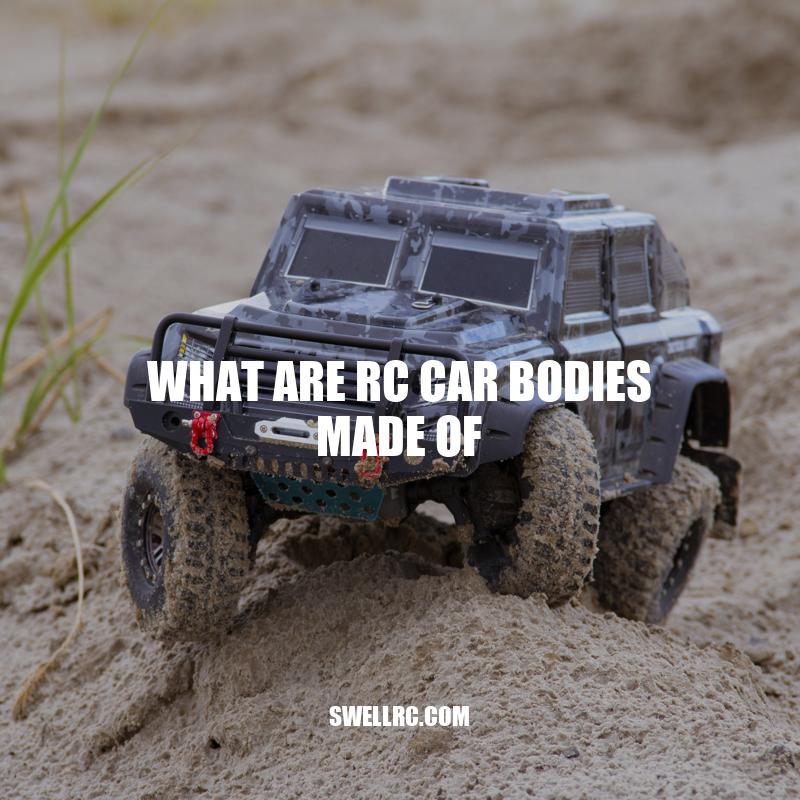RC Car Bodies: Exploring Different Materials
Remote Control (RC) cars are miniature cars that are powered by electric or gas motors and can be controlled by a remote for entertainment or sporting use. These cars are often scaled versions of their real-life counterparts and have become increasingly popular amongst car enthusiasts and competitive racers alike. The body of an RC car is aesthetically appealing and also plays a crucial role in performance, handling, and longevity. There are several different materials used in the construction of RC car bodies, each with their unique properties and characteristics. Polycarbonate, ABS, fiberglass, and Lexan are some of the most commonly used materials in the fabrication of RC car bodies. The chosen material will depend on the size and intended use of the car, as well as personal preference and budget. In this article, we will explore the different materials used in the construction of RC car bodies, their advantages, and their disadvantages.
Polycarbonate RC Car Bodies
Polycarbonate is a thermoplastic polymer that is popular in the production of RC car bodies. Listed below are some of its characteristics and advantages:
- Flexible material that can withstand hard impacts without cracking or breaking
- Durable and resistant to abrasion and impact damage
- Lightweight and available in various thicknesses
- Easy to modify or customize with paints, decals, and other graphics
- Widely available and relatively low cost
Some popular brands of polycarbonate RC car bodies include Traxxas, Proline, and JConcepts. Traxxas, one of the leading companies in the RC car industry, offers a wide range of polycarbonate bodies for their popular models such as Stampede and Rustler. Additionally, Proline offers a variety of replacement and upgrade polycarbonate bodies for various types of RC cars. JConcepts is another brand famous for their off-road racing bodies, and they offer a diverse range of polycarbonate bodies for various racing applications.
What material are RC car bodies made of?
RC car bodies are typically made of polycarbonate (PC) or lexan plastic due to their lightweight and durable nature. Some higher-end RC cars may also feature carbon fiber or aluminum bodies. These materials provide strength and flexibility, making them ideal for high-speed racing and off-road adventures.
For more information on RC cars and accessories, visit websites such as Horizon Hobby, Tower Hobbies, or AMain Hobbies.
ABS RC Car Bodies
ABS or Acrylonitrile Butadiene Styrene is another thermoplastic polymer used in the manufacture of RC car bodies. Below are some of its characteristics and advantages:
- Highly durable and sturdy material ideal for smaller RC cars
- Offers excellent stiffness and impact resistance
- Resistant to chemicals, heat, and abrasion
- Easy to mold and modify with paints and other finishes
- ABS is a more expensive material than polycarbonate or Lexan
| Advantages | Disadvantages |
|---|---|
| Highly durable and resistant to impacts and chemicals | More expensive than other thermoplastic materials |
| Easy to modify and customize | Not as flexible as polycarbonate or Lexan |
| Great stiffness and impact resistance | Less heat resistant than other materials such as fiberglass |
Some popular ABS RC car body brands include Tamiya, Protoform, and Bittydesign. Tamiya is one of the most popular RC car brands and offers a wide range of ABS RC car bodies for their various models. Protoform is another well-known brand that specializes in high-performance RC car bodies, and they offer several ABS bodies for different racing classes. Bittydesign is a relatively new brand but has gained popularity for their unique and high-quality ABS car bodies that are compatible with several RC car models.
What Thermoplastic is Used in Cars?
- Acrylonitrile butadiene styrene (ABS) is one of the most commonly used thermoplastics in car manufacturing due to its durability and heat resistance.
- Polycarbonate (PC) is also used in car manufacturing, particularly for headlight lenses, due to its transparency and impact resistance.
- Polypropylene (PP) is used for various car parts such as bumpers, interior trim, and fuel tanks due to its lightweight and toughness.
- Polyurethane (PU) is commonly used for car seats and dashboard padding for added comfort and flexibility.
For more information on car manufacturing materials, you can visit websites such as plasticsmakeitpossible.com or plasticomnium.com.
Fiberglass RC Car Bodies
Fiberglass is a composite material that is popularly used in the manufacture of RC car bodies. Below are some of its characteristics and advantages:
- Offers high level of stiffness, strength, and durability
- Lightweight and can improve the car’s overall performance
- Can be easily molded into any shape and curvature
- Paint adheres well and adds to the finish’s aesthetics
- Fiberglass can be repaired if it gets damaged
- Expensive compared to other plastic materials such as ABS and polycarbonate
| Advantages | Disadvantages |
|---|---|
| Highly durable and resistant to impacts and chemicals | More expensive than other plastic materials |
| Lightweight and improves the car’s overall performance | Not as flexible as polycarbonate or Lexan |
| Can be easily molded into any shape and curvature | Tends to splinter or chip at higher speeds |
Some popular fiberglass RC car body brands include HPI Racing, Killerbody, and McAllister Racing. HPI Racing is known for its high-quality fiberglass car bodies that are compatible with several RC car models. Killerbody is a relatively new brand but has quickly gained popularity for its finely detailed and high-quality fiberglass car bodies. McAllister Racing is another reputable brand that offers several fiberglass car bodies for oval track racing.
Is Fiberglass a Good Car Body?
Fiberglass is a popular material for car bodies due to its lightweight and durable properties. It is also cheaper than traditional steel or aluminum car bodies. However, fiberglass car bodies can have some disadvantages such as:
- Fiberglass can crack, chip or break more easily than steel or aluminum car bodies.
- Fiberglass can fade or discolor over time due to exposure to the sun.
- Fiberglass car bodies are harder to repair in case of damage or accidents.
Despite the disadvantages, fiberglass car bodies can be a good option for some car owners depending on their preferences and needs. It is recommended to do research and consult with a professional before making a decision on the type of car body to choose.
Lexan RC Car Bodies
Lexan is a brand of polycarbonate that is specifically designed for the manufacture of RC car bodies. Here are some of its characteristics and advantages:
- Superior impact resistance and durability compared to other thermoplastics
- Offers excellent flexibility, allowing for complex shapes and curves with ease
- Lightweight and improves the car’s overall performance
- Can be easily painted and polished for an appealing finish
| Advantages | Disadvantages |
|---|---|
| Highly durable and can withstand hard impacts and scratches | More expensive than regular polycarbonate |
| Offers excellent flexibility to achieve complex designs and shapes | Not as rigid as ABS or fiberglass, which can be a disadvantage for some RC cars |
| Allows for easy customization and painting | Prone to yellowing with prolonged exposure to sunlight |
Popular Lexan RC car body brands include Pro-Line Racing, JConcepts, and RPM R/C Products. Pro-Line Racing is a respected brand in the RC car community and offers a wide range of Lexan car bodies that are compatible with various RC car models. JConcepts is another reliable brand that is known for its durability and excellent fit with RC cars. RPM R/C products, on the other hand, specialize in RPM RC car parts and accessories, including Lexan car bodies that are made to last.
What is the best paint for Lexan RC bodies?
When it comes to painting Lexan RC bodies, the most common types of paint used are polycarbonate spray paint, enamel spray paint, and acrylic spray paint. However, the best paint for Lexan RC bodies is polycarbonate spray paint.
Polycarbonate spray paints are specially formulated to bond with the Lexan plastic material, providing a durable and flexible finish that can withstand the wear and tear of RC use. Some of the popular brands for polycarbonate spray paints include Tamiya, Spaz Stix, and Pactra.
It is important to note that proper preparation and masking are crucial for achieving a smooth and even finish with polycarbonate spray paints. Always clean and dry your Lexan body thoroughly, and use masking tape to protect areas that you don’t want to get painted.
For more information on painting Lexan RC bodies, check out websites such as RC Driver or RC Universe, which offer helpful tips and tutorials.
Conclusion
In conclusion, the material used in the manufacture of RC car bodies plays an essential role in the car’s performance, durability, and aesthetic appeal. Polycarbonate, ABS, fiberglass, and Lexan are the most commonly used materials in the fabrication of RC car bodies, each with its unique set of advantages and disadvantages. When selecting a material, one should consider the intended use of the vehicle, personal preferences, and budget. Budget-friendly materials such as ABS and fiberglass are suitable for smaller RC cars, and they offer excellent durability and strength. On the other hand, Lexan and polycarbonate are preferred by most RC car enthusiasts due to their superior loss and impact resistance. In summary, the choice of the RC car body material should be based on a balance between the intended use, budget, and personal preferences. Whatever material you choose, ensure it is of high quality to get maximum performance and value for your money.



